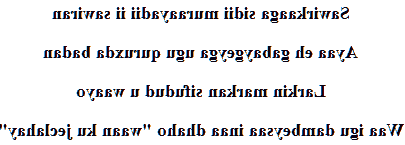Somali love poem
Muraayad
Sawirkaaga sidii muraayadii ii sawiran
Ayaa eh gabaygeyga ugu quruxda badan
Larkin markan sifudud u waayo
Waa igu dambeysaa inaa dhaho "waan ku jeclahay"


→ French poem ←
Somali language
A little translation into Somali (Common Somali, Af-Ashraaf, Standard Somali, Soomaaliga, Benaadir, Af-Maxaad Tiri, Northern Somali, Ogaden, Ashraaf, Degodia, Wardei, autonym : Af-Soomaali, Afka Soomaaliga), of my love poem (jacayl gabay).
Nearly two tens of millions of speakers speak Somali, this Cushitic, Chamito Semitic language from the Horn of Africa. They are found in Somalia, where it is the official language, as well as in Djibouti, Ethiopia, and Kenya.
Somali, which is the language of the majority of Somalis, is a language originating in southern Arabia which has several dialects which are not necessarily mutually understandable; it is the only Cushitic language to have written expression.
On the whole territory where it is spoken, Somali includes several dialect groups, these are: The Hawiya, spoken by the Hawiyas, almost all of them in Somalia, and in particular in Mogadishu; The Diguil-Rahanwin, spoken between the Webi Chébelli and the Djouba by the tribes of the same name; The Isâq, spoken both in Harar in Ethiopia, in Somaliland, and by the Isâq on the French Somali Coast; The Dârôd, spoken both by the people of the ancient Migiurtinia territories and some of those of ancient Obbia in Somalia, and also by the Dulbahanta and Warsanguéli of Somaliland and the Ogaden of Ethiopia and Oltregiuba.
It should be noted that some Somali groups use a specific form between them, and to address the outside world, a more common Somali.
In Somalia since Islamization, the written language has always been Arabic, it was for a long time for religious texts. When it was necessary to write in Somali, the Arabic script proved to be insufficiently adapted, so Osman Yousouf created the Osmanian which contained elements of the Arabic and Ethiopian scripts.
His son, Yasin Osman, founded in 1949 a Society for Somali Language and Literature, translated European texts and had many books printed. At that time, the language was modernized and enriched with translations and it was heard on the radio. In 1951, a regression begins, the two official languages of the country are Italian and Arabic, Somali remaining an oral language.
After the Somali independence in 1960, two alphabets among many were selected to write the language. One was Latin, the other Osmanian contained elements of the Arabic and Ethiopian scripts.
In 1973, when Somali became the country's official language, the government decreed that it would be written in the Latin alphabet.
Somalia and Somali people
The Somali coast has been known since antiquity by the Romans, Greeks, and Egyptians, who made this coast an important center of trade.
The Somali population is ethnically homogeneous. The Somalis settled in the Horn of Africa from the 10th century, pushing the Gallas towards present-day Ethiopia. Since then, the country has welcomed many refugees who were victims of conflicts.
The Somalis still practice pastoral nomadism; the herds are made up of camels guarded by young people, oxen, goats and sheep. Seasonal trips are made over short distances.